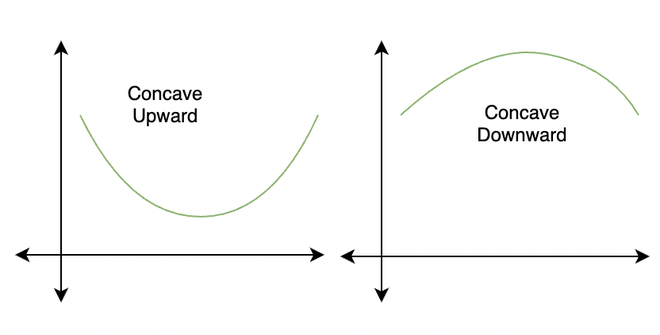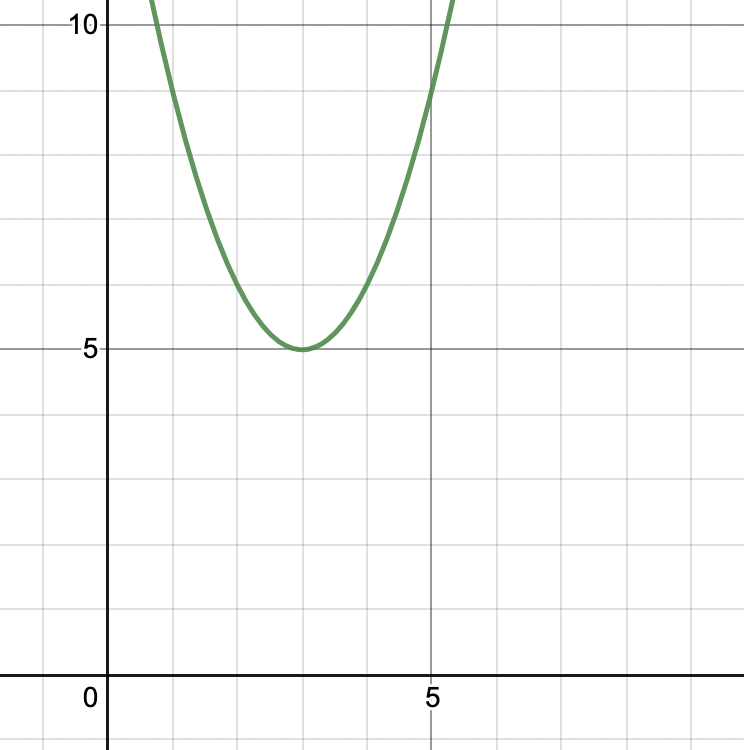
|
|
Graphs of the functions give us a lot of information about the nature of the function, the trends, and the critical points like maxima and minima of the function. Derivatives allow us to mathematically analyze these functions and their sign can give us information about the maximum and minimum of the function which is necessary for plotting the graphs. Sometimes simply knowing if a function’s graph is increasing or decreasing is not enough, we also need to look at the direction of the bending of the graph. The direction tells us whether the function is concave upwards or downwards. Let’s see how to identify these trends using derivatives. Table of Content What are Concave Functions?A Concave function is also called a Concave downward graph. Intuitively, the Concavity of the function means the direction in which the function opens, concavity describes the state or the quality of a Concave function. For example, if the function opens upwards it is called concave up and if it opens downwards it is called concave down. The figure below shows two functions which are concave upwards and concave downwards respectively.
Analyzing Concavity of Concave Functions Using GraphsThe concavity can also be identified by drawing tangents at points on the graph. For example, a graph is said to be concave up at a point if a tangent drawn to the graph at that point lies below the graph in the vicinity of that point. Similarly, the graph is said to be concave downward at a point if a tangent is drawn to the graph that point lies above the graph in the vicinity of that point. This can be seen in the figure given below, 
Notice that there can also be a point where the tangent drawn to it lies neither above the graph nor below the graph. Such tangents intersect the graph on that point. At such point, concavity changes from upwards to downwards or vice-versa. This point is called the point of inflection. 
Now let’s look at the formal definition for all these points,
Analyzing State of Concave Functions (Concavity) Using DerivativesThe above method is a graphical method of analyzing the concavity of the function, but sometimes we do not have the graph of the function. When we have no knowledge about the graph of the function, derivatives come to our rescue. Let’s say we have a function f(x). Considering the different cases given in the figure below, we know that the slope of the tangent gives us the value of the derivative of the function at that point of contact. 
Notice that in the figure above, when the function is concave downward, the slope of the tangent is decreasing in value which means the derivatives are decreasing. Similarly, when the function is concave upward the value of the derivatives is increasing. Thus, we can make the following conclusions:
We can draw mathematical rules from these observations given above,
Solved Examples on Concave FunctionExample 1: What should be the value of “a” for the function f(x) = ax3 + 4x2 + 1 to be concave downward at x = 1. Solution:
Example 2: What is the shape of the graph for the function f(x) = [Tex]\frac{1}{x + 4} [/Tex] at x = 2. Solution:
Example 3: What is the shape of the graph for the function f(x) = x2 + x + 1 at x = 0. Solution:
Example 4: What is the shape of the graph for the function f(x) = x3 + 4x2 + 1 at x = 0. Solution:
Example 5: Tell whether the graph of the function f(x) = ex + cos(x) is concave up or concave downward at x = 0. Answer:
Example 6: Plot the graph of the function f(x) = (x – 3)2 + 5. Solution:
Practice Questions on Concave Function1. Prove that f(x) = -x² is a concave function. 2. Is the function f(x) = ln(x) concave? Justify your answer. 3. Show that the sum of two concave functions is also concave. 4. Determine if f(x) = √x is concave on its domain. 5. Prove or disprove: If f(x) is concave, then -f(x) is convex. 6. Is the function f(x) = 1/x concave on (0, ∞)? Explain your reasoning. 7. Show that the minimum of two concave functions is concave. 8. Determine if f(x) = x³ is concave on R. 9. Prove that if f(x) is twice differentiable and f”(x) ≤ 0 for all x in the domain, then f(x) is concave. 10. Given that f(x) and g(x) are concave functions, is h(x) = f(g(x)) necessarily concave? Justify your answer. SummaryA concave function is a fundamental concept in mathematics, particularly in optimization and analysis. In a single variable context, a function f(x) is concave if its graph lies above or on any line segment connecting two points on the graph. More formally, for any two points x₁ and x₂ in the domain and any t ∈ [0,1], a concave function satisfies f(tx₁ + (1-t)x₂) ≥ tf(x₁) + (1-t)f(x₂). Geometrically, this means the function’s graph curves inward or “holds water.” For twice-differentiable functions, concavity is characterized by a non-positive second derivative. Concave functions have important properties: they have at most one global maximum, which, if it exists, is also a local maximum; the set of points where a concave function is greater than or equal to any real number is always convex; and they play crucial roles in economics, optimization theory, and probability theory, particularly in defining risk-averse utility functions and in convex optimization problems. FAQs on Concave FunctionWhat is the difference between a concave and a convex function?
How can I determine if a function is concave?
Are all parabolas that open downward concave functions?
Can a function be both concave and convex?
What are some real-world applications of concave functions?
|
Reffered: https://www.geeksforgeeks.org
| Class 12 |
Type: | Geek |
Category: | Coding |
Sub Category: | Tutorial |
Uploaded by: | Admin |
Views: | 8 |
